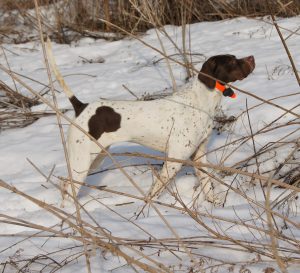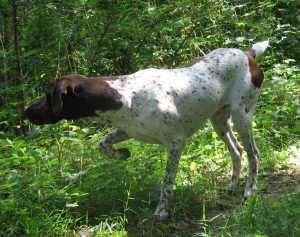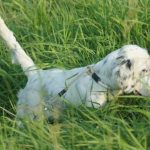POINTING DOG POINTERS: Problems in Developing the Started Dog – Pointing
By Bob and Jody Iler
“My pup’s not pointing!”
When you signed up to get a pointing dog pup, you dreamed about that day when your young dog would hunt with zest and abandon and suddenly – he would go on point! His tail ramrod straight, up in the air – his body immobile, yet quivering with intensity. Once a person has seen a class pointing dog on point, he is hooked. This is why we love our pointing dogs so much. And this is why we’re so concerned if our pup is having issues with pointing.
First off, relax! The first season for a young dog is comparable to elementary school for kids. Your pup is learning all sorts of new lessons that only experience in the field will teach him. And he won’t have all these lessons finely honed in just the first few months. A class pointing dog takes time to develop – patience, experience, training and time. And of course, a variety of birds.
In general, the pointing instinct is bred right into your dog. His genetic blueprint includes this important instinct, which may be stronger in some bloodlines than others. Genetics will also bless him with a superior, or maybe just average, nose, which will also play a role in how he points – for example, how often he finds a bird, and how close or far away he is from the bird that he points. A poor nose can cause a young dog to crowd his bird too close, not allowing him to point. This often results in pup busting the birds. Here in Iowa, spooky pheasants or running birds don’t sit tight. A good nose helps the pup have time to point. If pup’s mom and dad are staunch, classy pointers with good noses, chances are your pup will be, too. It’s important to see the pedigree of your prospective pup, but even more important to see his parents in the field.
We had three beautiful Shorthair females, all sisters from the same litter. Both parents had excellent bloodlines and intense pointing ability. Mom was a natural at everything she did. Her lineage was half German-bred champions and half American field trial champions. Dad was a noted field champion of the day. All three girls had tremendous get up and go – one was an all-age prospect. All three had tremendous noses. Two of the sisters pointed right off the bat and never wavered.
The third sister, Gretchen, would happily find her birds and run right in to flush them. During her training, we tried using a checkcord to keep her from jumping in, used spooky birds that she couldn’t catch, and did all that we could think of to promote some staunchness on point. We didn’t want to hamper her wonderful enthusiasm and drive to hunt, so we patiently kept working her and hoped for the best. It was over a year before Gretchen pointed. And when she did, that was it! She did not move as we spent long minutes walking around her, taking pictures to prove we weren’t imagining it! From that day on, Gretchen was as staunch on point as her sisters, and never lost her great love for hunting and pointing.
Moral of this story? Blood will usually tell. Be patient. Give your pup time. Keep his enthusiasm high with lots of bird work, fun, and field experience. We like to say that we’ll give a pup two years to come around and start pointing. If they don’t point by then, they are likely not going to – but if your pup has good bloodlines, there is every reason to be hopeful and give him the time he needs.
Another factor that can affect a pup’s point are scenting conditions. Is the weather dry, with dusty and hot conditions? Extremely wet? Too much wind or no wind at all? Sometimes scenting conditions can change very quickly. Ideal days with gentle breezes and cool mornings and evenings seem to be best for good scenting conditions. And good scenting conditions will help your pup to point more successfully.
During your training, if your pup catches too many birds because they are poor flyers, this can sometimes soften his point. In your training field, use a checkcord and have a helper flush the bird for you. Gently restrain the pup with the checkcord as the bird flushes. If it doesn’t fly far, lead your pup away on the checkcord so that he can’t run over and catch the bird. Continue these practice sessions in between hunts in the field and at the game preserve.
Poor flying quail can be great for young puppies learning to love birds, but bad for the older student that is learning – inadvertently – that he can catch birds and “doesn’t have to point.” Pigeons will work better during training at this point, as they are usually good flyers. Working your pup on wild birds will often help resolve this issue. He may bump or bust a few wild ones and soon learn that he must use caution and point the bird from a distance away.
Take time to know the bird population in the area you plan to hunt. If there aren’t many birds, your young dog has less opportunity to find and point birds! He’ll also lose his drive if he hunts for a good amount of time and goes birdless. At this stage, you want to keep his enthusiasm whetted by hunting him where he’ll find birds.
We often read articles about pointing dogs and retrievers hunting together. The pointers find and point the birds and then the retrievers step in and – well – retrieve the birds. This may work for some experienced dog combos and hunters, but when you are starting out with your young dog, you’ll want to hunt him on his own, particularly in the first season. He needs to learn the right kind of lessons that he can only learn by having the right kind of experiences. A retriever or flusher running in to flush the bird that he has pointed will not help your youngster learn staunchness on point.
Let’s review then. First, acquire a pup with good bloodlines. Genetics are important! Next, give your pup love, patience, proper training, and plenty of bird work. Make it fun. Hunt your pup alone with you during his first season, and whenever possible, hunt him on wild birds. Early on, try to hunt him in good hunting habitat with weather conditions that will help him be successful. Thoughtful effort and patience during this first season will pay dividends in the future!
Pointing Dog Pointers features monthly training tips by Bob and Jody Iler, who own Green Valley Kennels in Dubuque, Iowa. Bob and Jody have trained pointing dogs for over 35 years and have written many articles for Pointing Dog Journal.








